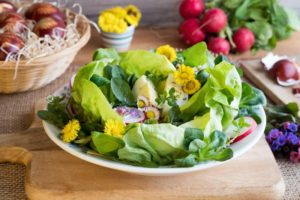
WEEDS FOR WELLNESS – DANDELION
 Finally the bright yellow flowers are brightening the landscape – a sure sign that spring is here to stay. Hard to believe that herbalists have great appreciation for this marvelous creation of nature? We use flowers, buds, leaves and roots as food and medicine. My grandkids nibble on the flowers and young leaves.
Finally the bright yellow flowers are brightening the landscape – a sure sign that spring is here to stay. Hard to believe that herbalists have great appreciation for this marvelous creation of nature? We use flowers, buds, leaves and roots as food and medicine. My grandkids nibble on the flowers and young leaves.
Last year I made a crown out of dandelion flowers for my then 4 year old grand daughter. She was wearing it proudly as we walked into Canadian Tire. With great joy I observed the reactions of customers especially when we were wandering around the Round-up shelf. So much fun!
Be creative and “brave” – eat flowers and young leaves, add both to salads, make a Dandelion flower cold infusion. Decorate ice creams and cakes … and most of all, have fun and be grateful for the gift of this plant that most consider to be a pesky weed.
DANDELION – Taraxacum off. – Asteraceae famly
PARTS USED: Roots, stems, leaves and flowers
HARVEST TIME
Roots: Spring before flowering or fall after first frost
Leaves: Early spring, throughout summer (leaves increase in bitter taste with age)
Flowers: When in full bloom
NUTRITIONAL VALUE
Rich in minerals such as calcium, iron, copper, magnesium, manganese, phosphorus, potassium, selenium, silicon, and zinc. Vitamins A, B complex, C and D.
Carotenoids, fatty acids, flavenoids and phytosterols.
NOTE: The roots are exceptionally high in vitamin A
THERAPEUTIC ACTIONS
Leaf: Diuretic (high in potassium) – Choleretic (stimulates bile production by liver) – Aperient (mild laxative)
Root: Bitter digestive tonic; nutritive – Choleretic, cholagogue – Aperient, laxative – Anti-rheumatic, anit-inflammatory (animal studies)
Sap: Keratolytic (breaks down outer layer of skin)
INDICATIONS
Leaf: Water retention
Root: Inadequate bile production, gallstones, liver/gall bladder insufficiency, congestive jaundice, Dyspepsia, lack of appetite
Sap of stalks, roots, or leaves: Warts, cankers
FORM OF PREPARATION
Infusions (leaves; flowers) – Decoctions (root) – Tinctures – Vinegars (roots, leaves, flowers) – Infused Oils – Salves – Food (leaves, petals, young roots)
CONTRA-INDICATIONS
No reported toxicity; however some people experience sensitivity reactions
WEEDS FOR WELLNESS – DANDELION
 Finally the bright yellow flowers are brightening the landscape – a sure sign that spring is here to stay.
Finally the bright yellow flowers are brightening the landscape – a sure sign that spring is here to stay.
Hard to believe that herbalists have great appreciation for this marvelous creation of nature? We use flowers, buds, leaves and roots as food and medicine. My grand kids nibble on the flowers and young leaves.
Last year I made a crown out of Dandelion flowers for my then 4 year old grand daughter. She was wearing it proudly as we walked into Canadian Tire. With great joy I observed the reactions of customers especially when we were wandering around the Round-up shelf. So much fun!
Be creative and “brave” – eat flowers and young leaves, add both to salads, make a Dandelion flower cold infusion. decorate ice creams and cakes … and most of all, have fun and be grateful for the gift of this plant that most consider to be a pesky weed.
DANDELION – Taraxacum off. – Asteraceae famly
PARTS USED: Roots, stems, leaves and flowers
HARVEST TIME
Roots: Spring before flowering or fall after first frost
Leaves: Early spring, throughout summer (leaves increase in bitter taste with age)
Flowers: When in full bloom
NUTRITIONAL VALUE
Rich in minerals such as calcium, iron, copper, magnesium, manganese, phosphorus, potassium, selenium, silicon, and zinc. Vitamins A, B complex, C and D.
Carotenoids, fatty acids, flavenoids and phytosterols.
NOTE: The roots are exceptionally high in vitamin A
THERAPEUTIC ACTIONS
Leaf: Diuretic (high in potassium) – Choleretic (stimulates bile production by liver) – Aperient (mild laxative)
Root: Bitter digestive tonic; nutritive – Choleretic, cholagogue – Aperient, laxative – Anti-rheumatic, anit-inflammatory (animal studies)
Sap: Keratolytic (breaks down outer layer of skin)
INDICATIONS
Leaf: Water retention
Root: Inadequate bile production, gallstones, liver/gall bladder insufficiency, congestive jaundice, Dyspepsia, lack of appetite
Sap of stalks, roots, or leaves: Warts, cankers
FORM OF PREPARATION
Infusions (leaves; flowers) – Decoctions (root) – Tinctures – Vinegars (roots, leaves, flowers) – Infused Oils – Salves – Food (leaves, petals, young roots)
CONTRA-INDICATIONS
No reported toxicity; however some people experience sensitivity reactions
WEEDS FOR WELLNESS – A GUIDE TO YOUR BACKYARD PHARMACY
 In the following weeks I will share information about some of the so-called weeds and how you can add them to your food menu. Many of the “weeds” have a greater nutritional value than cultivated vegetables.
In the following weeks I will share information about some of the so-called weeds and how you can add them to your food menu. Many of the “weeds” have a greater nutritional value than cultivated vegetables.
Let’s start with the “pesky” DANDELION that adds so much vibrant yellow to the landscape right now; the blossoms look like little suns reaching up to the sky. Dandelion is a great friend for an ailing digestive system. Medicinally the leaves are used internally as a diuretic and stimulant for the gall bladder; the root provides support for the digestive system especially the liver. The milky juice from the stems is applied externally to warts and skin blemishes.
Dandelion GREENS are more nutritious than spinach; they contain many vitamins (i.e. vitamin A, C and D) and minerals (i.e. calcium, potassium and iron). Another constituent, photosterols support the body by preventing the accumulation of cholesterol.
The greens should be harvested before the flowers appear; either for immediate use or kept in the fridge for up to 5-6 days after they have been rinsed with cold water. You may want to store them in a damp dish towel. Leaves that are lighter in colour have less of a bitter taste as do younger leaves.
FOOD USES: My favorite is to add Dandelion greens to a salad, scrambled eggs or the Jungle Juice (see previous post). You can also add them to smoothies, guacamole or baking such as pancakes, muffins and biscuits.
Dried leaves, stored in an airtight container, can be prepared as an infusion (tea).
FLOWERS: Gather while in full bloom and fully open. Pluck the petals and add to any baking or water to make a cold infusion. Dandelion flowers don’t keep well, therefore they should be used within a few hours of harvesting. You can also make wine or syrup from the flowers.
ENJOY and be creative. Feel free to share your Dandelion experiences and recipes.
Stay tuned for the next weedy post.



Follow Us!